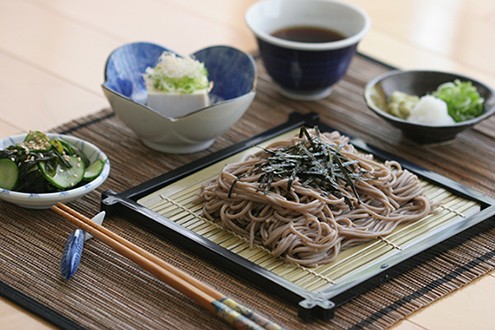
Japanese Soba Noodles
Soba noodles are delicious both warm and cold. This lovely cold soba salad from Karen Chan is no exception.
Text And Photos By Karen Chan


Cold soba noodles are one of those things that’s perfect on a hot day. It’s super refreshing and even though they’re subtle, the flavors are so delicious that you feel content and satisfied after your meal. Soba is very easy to make and it’s sure to be a hit every time you make it.
Japanese Soba Noodles
4 Servings
- 2 quarts (2l) water
- 12 oz (340 g) dried soba/buckwheat noodles
- 1 1/2 cups (3.75dl) dashi stock
- 5 tablespoon soy sauce
- 3 tablespoons mirin
- 1 tablespoon sugar
- 1 sheet toasted seaweed/nori
- 2 green onions
- 4 teaspoons wasabi powder
- 2 teaspoons grated daikon/Japanese radish
To Cook the Noodles
1. Heat 2 quarts of water to a boil in a large pot on high. Add small bundles of the noodles at a time, separating gently by stirring. When the water reaches a full boil again, add 1 cup of cold water. Repeat this process twice. When the water returns to a full boil, check the noodles to see if they’re done. You want them to be firm-tender. Do not overcook the noodles.
2. Drain the noodles through a collander and rinse well under cold running water to cool the noodles.
3. The purpose of this is not only to stop the cooking process, but also to remove the starch from the noodles. This is an essential part of soba noodle making. Once the noodles are cooled, drain them and cover them with a damp kitchen towel and set them aside allowing them to cool completely.
To Prepare the Dipping Sauce
1. Dashi stock can either be purchased pre-made, it can be made from scratch, or it can be made by mixing and diluting instant dashi granules. I chose to buy insant dashi granules at a local Japanese market. Any brand you find will come with directions on the back for how to make the stock. The dashi I found thankfully came with instructions in both Japanese and English. I used the proportions of 1 teaspoon of dashi granules for 6 cups of water. I would say this was on the weaker side, which was what I was in the mood for – mild dipping sauce so I could really appreciate the taste and consistency of the buckwheat noodles.
2. After making your dashi stock, bring the dashi stock, soy sauce, mirin and sugar to a boil in a saucepan over medium-high heat. Stir gently to dissolve the sugar. Once completely dissolved, allow the sauce to cool completely. You may refrigerate if you desire a cold dipping sauce (on a particularly hot day).
To Arrange the Dish
See Also


Pasture Beef Ginger Soba Bowl
1. This meal’s garnishes are almost as important as the noodles themselves. Using kitchen sheers, cut the sheet of nori crosswise into quarters. Then cut those quarters crosswise into 1/8-inch wide strips.
2. Next, very thinly chop the green onions on the bias.
3. Mix wasabi to desired consistency, cover and let stand for 10 minutes.
4. Grate diakon (Japanese radish) using a microplane or similar grater.
5. Traditionally soba is served on a bamboo basket tray, but if you don’t have these, you can simply serve them on a plate or in a bowl. Divide up the noodles, laying them on your serving dishes. Sprinkle each with 1/4 of the nori. In small side bowl or cup, place 1/2 cup of dipping sauce into each. In separate small side dishes, serve each person a small amount of wasabi, grated daikon, and green onions.
6. The noodles are eaten by sprinkling the desired garnishes into the dipping sauce and eating the noodles by first dipping them into the sauce. Feel free to slurp away! Oishii!
Average Rating